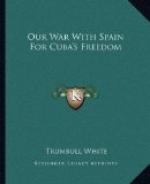The Baron describes with rapture the sabino, so called by the natives, but by him called the talauma; it is from fifteen to twenty feet high, with spreading branches, having large silvery leaves and bearing immense white, odorous flowers. The hietella is another tree that has remarkable leaves and yields beautiful crimson flowers. He describes still another tree, without naming it, as having orangelike foliage, large purple flowers, and as having in its neighborhood other trees, different from it, but resembling it and evidently allied to it. This tree, he says, is not found elsewhere. Still another tree, the ortegon, whose flowers are purple spikes a yard long, and whose wood is used for timber, is common on the high lands near the coast. And there are dye woods, mahogany and lignum vitae. Hence it is seen that the forests of Puerto Rico are generally beautiful, and strange in some of their features.
The words Puerto Rico are, when translated, Rich Port, and they are very applicable to this snug spot in the Atlantic ocean, only a short distance off the United States coast. Every variety of soil is adapted to the growth of a particular kind of crop. The highest hills, as the lowest valleys, are cultivated with reference to what they will best produce. On the hills, rice; in the valleys, coffee, cotton and sugar cane; on the rising grounds between the valleys and hills, tobacco. Puerto Rico rice, unlike that of the Carolinas, grows on dry lands, even on the highest hills, without watering. It is the staple food of the laborers. The consular report to Washington for 1897 says the product of coffee that year was 26,655 tons; of sugar, 54,205 tons, and of tobacco, 1,039 tons. The number of bales of cotton is not given, but the consul expatiates on its fine quality. The richness of the sugar lands may be judged from this item in the report: “Three hogsheads of sugar is an average yield per acre, without using fertilizers of any kind.”
Puerto Rico is one of the finest grazing countries in the world. Its herds of cattle are immense, and from them are supplied cattle of a superior quality to the other West India islands. Great quantities of hides are shipped to various countries.
Though richly agricultural as the island is, and entitled as it is to be regarded as exclusively agricultural, in past times considerable mining was done there, in gold, copper and salt. Indeed, copper is still mined to a small extent, and salt is still so plentiful that the government finds a profit in monopolizing the sale of it.
Puerto Rico is only 100 miles in length and from fifty to sixty miles in breadth, and as square as a dry-goods box. East and west and north and south its coast lines run almost as regularly as if projected by compass. It is the delight of the sailorrnan, as its fertile soil is the joy of the agriculturist.
The harbor of San Juan is the chief in Puerto Rico, and one of the best of its size in the Caribbean sea. It is safe and sheltered, large and land-locked, and though the entrance is somewhat “foul,” ships drawing three fathoms can enter and find anchorage within, good holding ground being had at any depth up to six fathoms. The bay is broad as well as beautiful, and opens toward the north, so that a vessel laying her course from New York could, if there were no obstructions en route, sail directly into the harbor.




